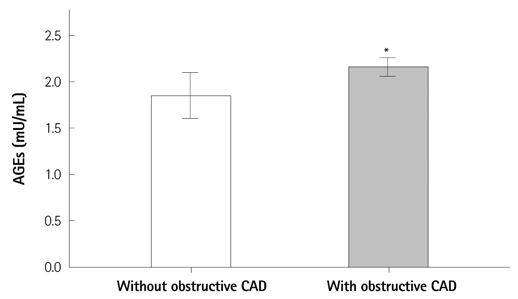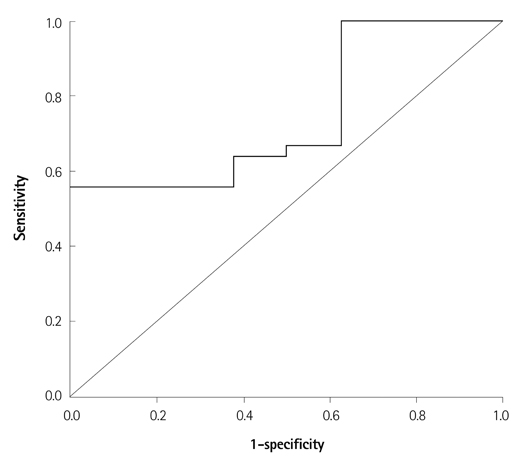Korean Circ J.
2012 May;42(5):335-340. 10.4070/kcj.2012.42.5.335.
High Serum Advanced Glycation End-Products Predict Coronary Artery Disease Irrespective of Arterial Stiffness in Diabetic Patients
- Affiliations
-
- 1Department of Cardiology, Yonsei Cardiovascular Center, Yonsei University College of Medicine, Seoul, Korea. hjchang@yuhs.ac
- 2Department of Cardiology, Myongji Hospital Cardiovascular Center, Kwandong University College of Medicine, Goyang, Korea.
- KMID: 2028762
- DOI: http://doi.org/10.4070/kcj.2012.42.5.335
Abstract
- BACKGROUND AND OBJECTIVES
Advanced glycation end-products (AGEs) contribute to the development of atherosclerosis. We investigated whether serum AGEs are related to the presence or severity of coronary artery disease (CAD), and explored the association between serum AGEs and arterial stiffness according to diabetes status in patients suspected of having CAD.
SUBJECTS AND METHODS
The measurement of serum AGEs and brachial-ankle pulse wave velocity (baPWV) were performed in 145 consecutive patients (63+/-9 years, 58% men) who received a coronary angiogram for evaluation of CAD.
RESULTS
Forty-four diabetics and 101 non-diabetics were classified into three subgroups based on the number of diseased vessels with obstructive CAD: 0, 1, and 2 or more vessel diseases (VDs). Serum AGEs were significantly higher in diabetics with obstructive CAD than in those without obstructive CAD (2.16+/-0.29 vs. 1.85+/-0.29 mU/mL, p=0.010) and were significantly correlated with the number of VDs only in diabetics (r=0.504, p<0.001). Serum AGEs were not significantly correlated with baPWV in diabetics or non-diabetics. In receiver operating characteristics analysis, the cut-off value of serum AGEs as a predictor of obstructive CAD was 1.98 mU/mL, with 64% sensitivity and 63% specificity in diabetics. In multiple regression analysis, serum AGEs independently predicted obstructive CAD and were associated with the number of VDs in diabetics.
CONCLUSION
Serum AGEs independently predict obstructive CAD and the severity of coronary atherosclerosis irrespective of arterial stiffness only in diabetics. Evaluation of PWV and serum AGEs together may be more effective to identify the risk of CAD in diabetic individuals.
Keyword
MeSH Terms
Figure
Reference
-
1. Kannel WB, McGee DL. Diabetes and cardiovascular disease: the Framingham study. JAMA. 1979. 241:2035–2038.2. Haffner SM, Lehto S, Rönnemaa T, Pyörälä K, Laakso M. Mortality from coronary heart disease in subjects with type 2 diabetes and in nondiabetic subjects with and without prior myocardial infarction. N Engl J Med. 1998. 339:229–234.3. Turner RC, Millns H, Neil HA, et al. Risk factors for coronary artery disease in non-insulin dependent diabetes mellitus: United Kingdom Prospective Diabetes Study (UKPDS: 23). BMJ. 1998. 316:823–828.4. De Vegt F, Dekker JM, Ruhé HG, et al. Hyperglycaemia is associated with all-cause and cardiovascular mortality in the Hoorn population: the Hoorn Study. Diabetologia. 1999. 42:926–931.5. Schleicher ED, Wagner E, Nerlich AG. Increased accumulation of the glycoxidation product N(epsilon)-(carboxymethyl)lysine in human tissues in diabetes and aging. J Clin Invest. 1997. 99:457–468.6. Reddy GK. AGE-related cross-linking of collagen is associated with aortic wall matrix stiffness in the pathogenesis of drug-induced diabetes in rats. Microvasc Res. 2004. 68:132–142.7. Sutton-Tyrrell K, Najjar SS, Boudreau RM, et al. Elevated aortic pulse wave velocity, a marker of arterial stiffness, predicts cardiovascular events in well-functioning older adults. Circulation. 2005. 111:3384–3390.8. Mattace-Raso FU, van der Cammen TJ, Hofman A, et al. Arterial stiffness and risk of coronary heart disease and stroke: the Rotterdam Study. Circulation. 2006. 113:657–663.9. Kilhovd BK, Berg TJ, Birkeland KI, Thorsby P, Hanssen KF. Serum levels of advanced glycation end products are increased in patients with type 2 diabetes and coronary heart disease. Diabetes Care. 1999. 22:1543–1548.10. Kiuchi K, Nejima J, Takano T, Ohta M, Hashimoto H. Increased serum concentrations of advanced glycation end products: a marker of coronary artery disease activity in type 2 diabetic patients. Heart. 2001. 85:87–91.11. Kanauchi M, Tsujimoto N, Hashimoto T. Advanced glycation end products in nondiabetic patients with coronary artery disease. Diabetes Care. 2001. 24:1620–1623.12. Semba RD, Najjar SS, Sun K, Lakatta EG, Ferrucci L. Serum carboxymethyl-lysine, an advanced glycation end product, is associated with increased aortic pulse wave velocity in adults. Am J Hypertens. 2009. 22:74–79.13. Choi EY, Kwon HM, Ahn CW, et al. Serum levels of advanced glycation end products are associated with in-stent restenosis in diabetic patients. Yonsei Med J. 2005. 46:78–85.14. Tarchalski J, Guzik P, Wysocki H. Correlation between the extent of coronary atherosclerosis and lipid profile. Mol Cell Biochem. 2003. 246:25–30.15. Tanaka S, Avigad G, Brodsky B, Eikenberry EF. Glycation induces expansion of the molecular packing of collagen. J Mol Biol. 1988. 203:495–505.16. Tsilibary EC, Charonis AS, Reger LA, Wohlhueter RM, Furcht LT. The effect of nonenzymatic glucosylation on the binding of the main noncollagenous NC1 domain to type IV collagen. J Biol Chem. 1988. 263:4302–4308.17. Boutouyrie P, Tropeano AI, Asmar R, et al. Aortic stiffness is an independent predictor of primary coronary events in hypertensive patients: a longitudinal study. Hypertension. 2002. 39:10–15.18. Najjar SS, Scuteri A, Lakatta EG. Arterial aging: is it an immutable cardiovascular risk factor? Hypertension. 2005. 46:454–462.19. Bucala R, Tracey KJ, Cerami A. Advanced glycosylation products quench nitric oxide and mediate defective endothelium-dependent vasodilatation in experimental diabetes. J Clin Invest. 1991. 87:432–438.20. Bucala R, Makita Z, Vega G, et al. Modification of low density lipoprotein by advanced glycation end products contributes to the dyslipidemia of diabetes and renal insufficiency. Proc Natl Acad Sci U S A. 1994. 91:9441–9445.21. Kirstein M, Brett J, Radoff S, Ogawa S, Stern D, Vlassara H. Advanced protein glycosylation induces transendothelial human monocyte chemotaxis and secretion of platelet-derived growth factor: role in vascular disease of diabetes and aging. Proc Natl Acad Sci U S A. 1990. 87:9010–9014.22. Yan SD, Schmidt AM, Anderson GM, et al. Enhanced cellular oxidant stress by the interaction of advanced glycation end products with their receptors/binding proteins. J Biol Chem. 1994. 269:9889–9897.23. Basta G. Receptor for advanced glycation endproducts and atherosclerosis: from basic mechanisms to clinical implications. Atherosclerosis. 2008. 196:9–21.24. Wautier MP, Chappey O, Corda S, Stern DM, Schmidt AM, Wautier JL. Activation of NADPH oxidase by AGE links oxidant stress to altered gene expression via RAGE. Am J Physiol Endocrinol Metab. 2001. 280:E685–E694.25. Bucala R, Makita Z, Koschinsky T, Cerami A, Vlassara H. Lipid advanced glycosylation: pathway for lipid oxidation in vivo. Proc Natl Acad Sci U S A. 1993. 90:6434–6438.26. Ono Y, Aoki S, Ohnishi K, Yasuda T, Kawano K, Tsukada Y. Increased serum levels of advanced glycation end-products and diabetic complications. Diabetes Res Clin Pract. 1998. 41:131–137.27. Makita Z, Radoff S, Rayfield EJ, et al. Advanced glycosylation end products in patients with diabetic nephropathy. N Engl J Med. 1991. 325:836–842.28. Yamashina A, Tomiyama H, Takeda K, et al. Validity, reproducibility, and clinical significance of noninvasive brachial-ankle pulse wave velocity measurement. Hypertens Res. 2002. 25:359–364.29. Sugawara J, Hayashi K, Yokoi T, et al. Brachial-ankle pulse wave velocity: an index of central arterial stiffness? J Hum Hypertens. 2005. 19:401–406.
- Full Text Links
- Actions
-
Cited
- CITED
-
- Close
- Share
- Similar articles
-
- The Role of Advanced Glycation End Products in Diabetic Vascular Complications
- Inhibition of advanced glycation end product formation by burdock root extract
- Diabetes and Heart Failure
- Serum Levels of Advanced Glycation End Products Are Associated with In-Stent Restenosis in Diabetic Patients
- Correlation of advanced glycation end products and heme oxygenase-1 in Korean diabetic patients




